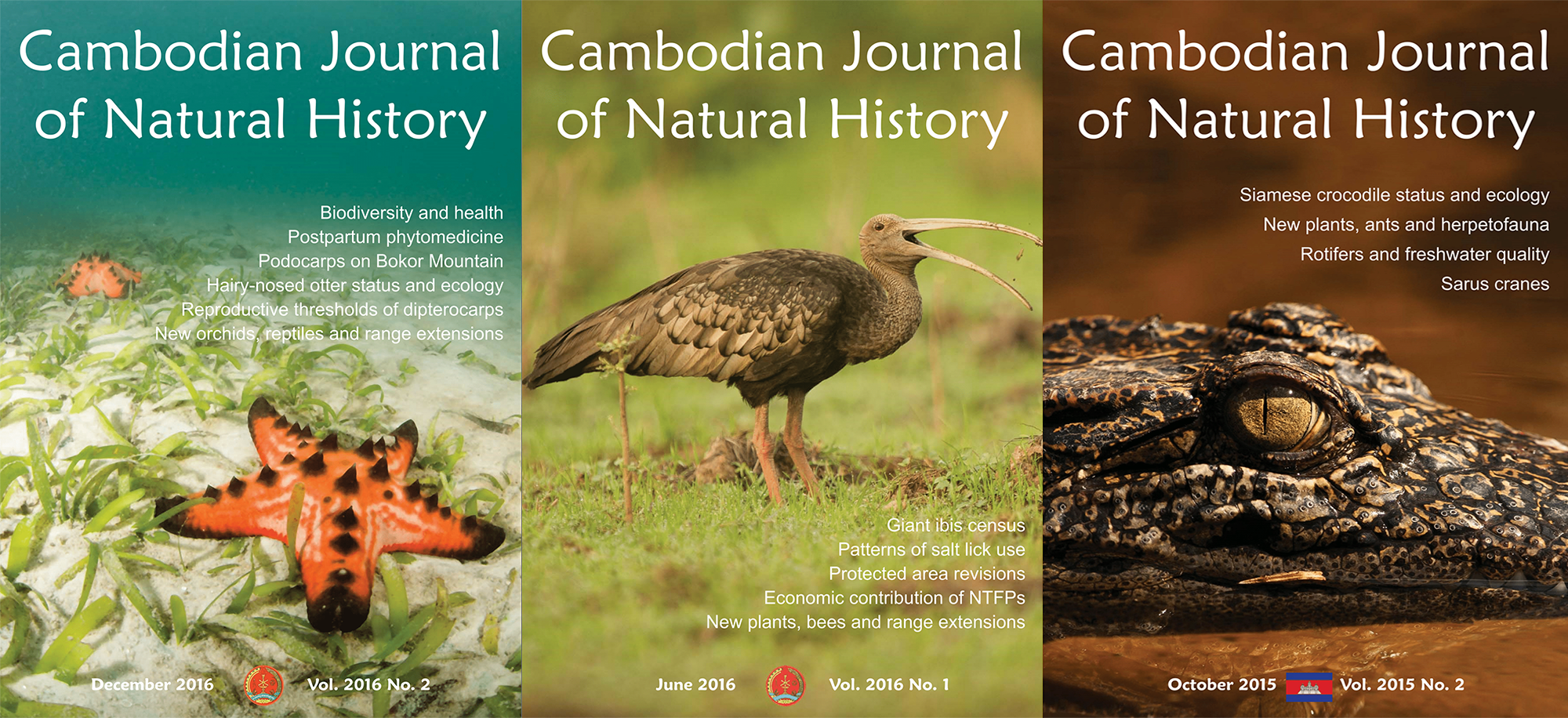CAMBODIA'S FIRST PEER-REVIEWED
SCIENTIFIC JOURNAL
The Cambodian Journal of Natural History (ISSN 2226–969X), Cambodia’s first peer-reviewed scientific journal, was launched in 2008 by Fauna & Flora and the Royal University of Phnom Penh as part of the University Capacity Building Project.
Aimed at helping Cambodian scientists to share their findings and improve their writing skills, the journal is open access and addresses the critical need for information on the conservation status and management requirements of Cambodian biodiversity.
All papers are peer-reviewed by leading national and international scientists and published in English.
Many of the journal’s authors are Cambodians with little experience of writing scientific papers, and our editors gently coach novice authors to develop their analysis and presentation.
Young scientists are thus gaining valuable new skills and confidence to write up their work, while distinguished veterans can use the journal to ensure their findings reach a wide audience in Cambodia.
The journal is published biannually in June and December each year by the Centre for Biodiversity Conservation (CBC) at the Royal University of Phnom Penh. The CBC is a non-profit making unit dedicated to training Cambodian biologists and the study and conservation of Cambodia’s biodiversity.
PURPOSE AND SCOPE OF THE JOURNAL
The Cambodian Journal of Natural History publishes original work by Cambodian and foreign scientists on all aspects of Cambodian natural history, including the status and ecology of species and habitats, new records, range extensions and checklists for species, landscape ecology, conservation policies and management plans, and human use of natural resources. The journal accepts original work by:
- Cambodian and foreign scientists on any aspect of Cambodian natural history
- Cambodian scientists on natural history studies in any part of the world
MANUSCRIPTS ACCEPTED
- Full papers (2,000–7,000 words, excluding references)
- Short communications (300–2,000 words, excluding references)
- News (<300 words)
- Letters to the editor (<650 words)
The primary language of the journal is English, although authors of full papers are also encouraged to include a Khmer translation of their abstract. Manuscripts are accepted on a rolling basis each year and can be submitted by email to the editors at any time (Editor.CJNH@gmail.com or Editor.CJNH@rupp.edu.kh)
Before preparing a manuscript, authors are advised to consult previous issues of the journal for general style. Specific guidance on manuscript preparation and submission requirements are provided in the Instructions for Authors. Authors are encouraged to contact the editors at any time if questions arise.
Each volume of the journal includes summaries of recent literature on Cambodian biodiversity and natural resource management. Authors are encouraged to send copies or links to recent publications (<18 months) which can include journal papers, technical reports, conference presentations and student theses.
READERSHIP
The journal’s readership includes conservation professionals, academics, government departments, non-governmental organisations, students and interested members of the public in Cambodia and overseas. In addition to being freely available online, printed copies of the journal are distributed in Cambodia.
INTERNATIONAL EDITORIAL BOARD
Dr Neil M. Furey, Fauna & Flora, Cambodia.
Dr Nicholas J. Souter, Conservation International, Cambodia.
Dr Ith Saveng, Royal University of Phnom Penh, Cambodia.
Dr Sok Serey, Royal University of Phnom Penh, Cambodia.
Dr Alison Behie, Australia National University, Australia.
Dr Chet Chealy, Royal University of Phnom Penh, Cambodia.
Mr Chhin Sophea, Ministry of Environment, Cambodia.
Dr Martin Fisher, Editor of Oryx – The International Journal of Conservation, UK.
Dr Thomas N.E. Gray, Wildlife Alliance, Cambodia.
Mr Khou Eang Hourt, National Authority for Preah Vihear, Cambodia.
Ms Meas Seanghun, Royal University of Phnom Penh, Cambodia.
Dr Ou Chouly, Virginia Polytechnic Institute and State University, USA.
Dr Nophea Sasaki, Asian Institute of Technology, Thailand.
Dr Bryan L. Stuart, North Carolina Museum of Natural Sciences, USA.
Dr Sor Ratha, Ghent University, Belgium.


